#ww 2 aircraft
Text

Valkyrie- she is so gorgeous! 54 years ago February 4th 1969 was her last flight. She took off from Edwards Air Force Base,CA and flew to the National Airport Museum in Dayton Ohio for her retirement. Over the next few days I'll be posting a lot more about her. Out of, all the aircraft in history that I've studied. From the Wright flyer to the F-35, J20, Su 57 and of course the one that is the most badass ass of all thee F-22 Raptor! The Xb70 valkyrie has been my favorite I started actively researching aircraft at the age of six, 1974. I would dream daily of seeing her. As of yet I've never seen her in person. That all changes in about 2 months, I'll be seeing her for the first time in her new birth and I am very excited. I've been by the museum three times, but I was only on the East Coast for family emergencies! I grew up and have lived my life on the west coast, in Seattle! Being an aviation historian, has been a fun lifelong Pursuit, full of passion! Valkyrie is truly the most beautiful aircraft I've ever laid eyes on!
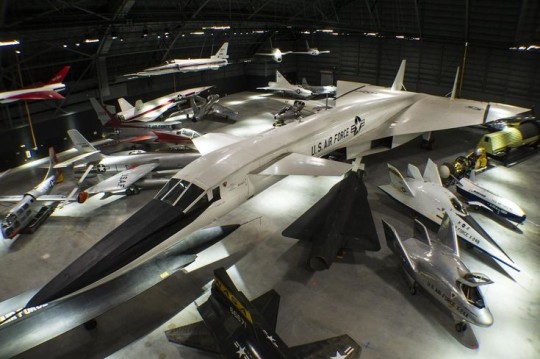








#wingnutz360#aircraft#aviation history#warbirds#avgeek#aviation lovers#military aviation#aviation news and photos with david arkwright#ww 2#f14 tomcat#xb70valkryie#xplane#usaf#USAFMUSEUM#nasa picture of the day#80000 FT MACH 3
117 notes
·
View notes
Text

Inspiration Gallery.
#Aircraft #WW II #remember #respect #ski #wings #old time #aviation #RAF #look sharp #elegant notes #allies #Battle of Pacific Ocean #history #Navy #A-2 #flight jacket #men's work #clothing with character
10 notes
·
View notes
Photo
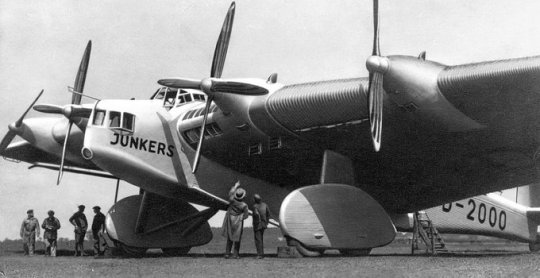
The Junkers G.38 was probably the first giant airliner to achieve (limited) commercial success.
Two aircraft were built and served with Lufthansa until the outbreak of WW 2, when the remaining G-38 was recruited into the Luftwaffe! It was destroyed by the RAF in Greece in 1941.
30 notes
·
View notes
Video
Night Witches & Polikarpov Po-2 by Willard Womack
Via Flickr:
During the War American and British women flew military aircraft. They ferried them from the factories, towed targets, flew test flights, ETC, but they did not fly in combat. Russian women flew Combat. There were two Regiments, one flying fighters, Yak 1s. The other flying bombers, the Polikarpov Po-2. Designed for crop dusting it looked like a WW I biplane, and carried only two small bombes. For safety, the bombers flew only at night. A lead plane, with flares, would illuminate the target area. The bombers would switch off their engines, and dive on the target, drop their two bombs, switch the engine on and fly back to the base to rearm. As many as eight mission may be flown in one night. With the engines switched off the planes made a swooshing sound in their dive. To the Germans it sounded like Witches flying on their brooms, and they called then, “Night Witches”. The parachutes, for the flares, were made of silk. One Pilot used some to make underwear for the other girls. She was arrested, Court Martial, and sentenced to death. However, the sentence was never carried out. They were very effective. Not only doing damage to the German Army, but also demoralizing the men. There was a bounty on them for anyone that brought one of the bombers down.
13 notes
·
View notes
Photo


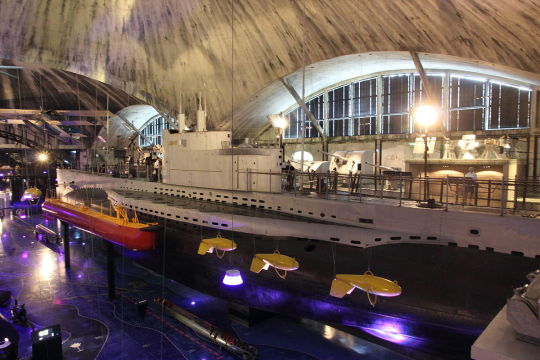


Lembit: a submarine like a pre-WW 2 time capsule
This post is a little different in various ways: it is about a military ship (stretching the definition of “infrastructure”), it touches on political history and most importantly, it is the first time I could visit the subject of a post myself and take some photos of my own. This was made possible due to an internship at the Estonian Maritime Museum (Eesti Meremuuseum) which allowed me to see one of the highlights of the museum for free, the submarine Lembit, wonderfully preserved and mostly restored to its original pre-WW 2 interior.
Until it was carefully lifted out of water in 2011 and turned into a museum ship in the Lennusadam (Seaplane Harbor) part of the Estonian Maritime Museum, it was the oldest submarine still afloat, having been custom-built in 1935-1936 in England and in 1937 taking part in the coronation naval parade of King George VI before being transferred in the same year to the Republic of Estonia to patrol its long coasts and train sailors. It is the only boat of its pre-WW 2 navy that remains intact, having survived WW 2 (unlike its sister ship Kalev, after which the this class of submarines are called Kalev class submarines) and the years of German and Soviet occupation during and the Soviet occupation after it. After the regaining of independence of Estonia in the early 90s and before becoming an exhibition object, during 1992-1994 it oversaw the departure of former Soviet troops that the occupiers had stationed in the country. (For more historical context, see the Wikipedia article on the history of Estonia)
Visiting the submarine is a bit like traveling back in time, aside from some modern lighting, a few loudspeakers and some protective glass the submarine is still largely how it was during its early years of service in the late 1930s, with most of the Soviet alterations (such as a training pool installed in it at one point) removed during restoration works in the 21st century. The new resting spot in the museum not only makes it possible to view the submarine from unusual angles that would usually require diving, but also protects the vessel against further corrosion.
Built by the Vickers-Armstrong Ltd. company in Britain by British workers and Estonian naval personnel under the (according to contemporary British statements) enthusiastic oversight of Estonian experts, the submarine has a number of special features. It was able to move through thin ice, which was needed due to large parts of the Baltic Sea regularly freezing over during the winter.
Furthermore, it could lay special mines designed in Estonia, possesses an anti-aircraft gun manufactured in Sweden as well as a machine gun, and, unusually, could fire two types of torpedoes, which were measuring 5.86/7 m (19.2/23 ft) in length and weighing 910/1565 kg. Eight could be on board in total, stored in the room at the bow (the front) of the ship, where also a majority of the personnel slept (16 out of 29-30, not counting officers).


The ship itself is 59.5 m (195 ft 3 inch) long and could displace 665 tons of water when surfaced and 853 tons when submerged. Next to the torpedo room is the saloon of the officers with more comfortable beds with curtains, the captain’s cabin (the only one to have a dedicated cabin) as well as a table with chairs and a bathroom restricted to the four officers onboard.
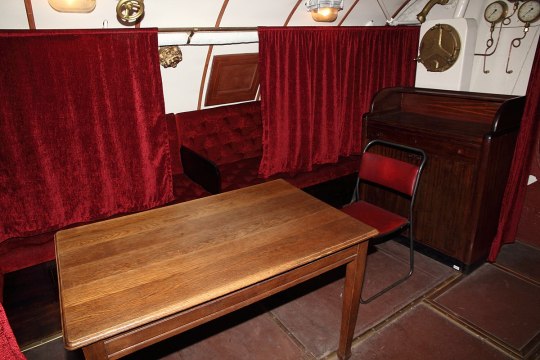
Neighboring the living room of the officer is the control room. It contains the steering wheel, a periscope, a desk with a map of the waters, the radio room, the galley (the kitchen) of the ship as well as numerous other devices and objects. Notable is that the water sink has two water taps, a sign that the ship was built in Britain.

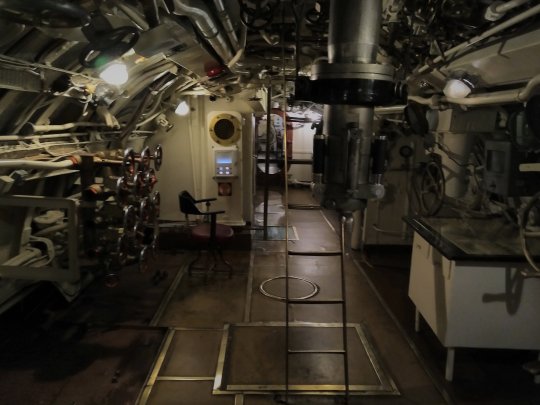


The two photos on the top show the control room seen coming from the bow, whereas the third photo shows the view coming from the opposite side, where the engine room is located. The submarine has two diesel and two electric engines onboard and could stay underwater for about a day at a maximum depth of 90 m (295 ft).
While surfaced, it could endure up to 28 days away from coasts or support ships and its range was 2,800 nautical miles (5185.6 km/3222.2 miles) surfaced and 90 nautical miles (166.7 km/103.6 miles) submerged. These lengths were however significantly reduced if going at maximum speed (8.5 knots / 15.7 km/h submerged and 13.7 knots / 25.4 km/h surfaced).
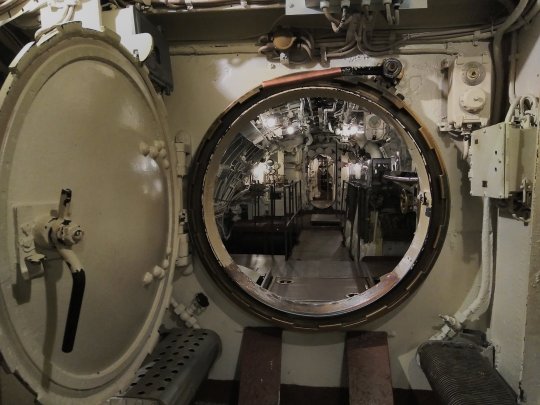

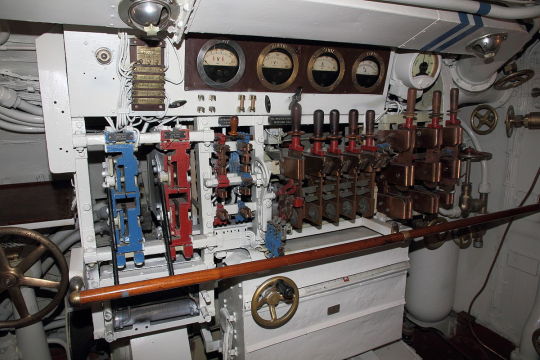

Topmost picture: The engine room, coming from the stern (the back) of the submarine. Second photo from top shows a similar view, here one of the electric engines is also clearly visible in the lower left corner. Second photo from the bottom: Controls of the electric engines. Bottommost photo: The diesel engines.
The last room had additional beds for sailors, additional devices and machinery as well as the toilet of the sailors and chests with their personal belongings.


Further reading:
Introduction on the homepage of the museum
Arto Oll: Allveelaevad Kalev ja Lembit / Submarines Kalev and Lembit (2019)
Arto Oll: Kalev ja Lembit. Eesti allveelaevade lugu (2017)
Uboat.net: Allied Warships of WW II, Lembit
Image sources:
Black/white photos: Unknown author, Public Domain, via Wikimedia Commons
Color photos: Photos released into the public domain by Wikimedia Commons user MKFI (interior photo of the museum, torpedo room overview, saloon, diesel engines and controls of the electric engines) and photos taken by the author.
2 notes
·
View notes
Text
Got a good start on the Bride and friends today and should be able to finish them off tomorrow (Friday) and then seal and grass ‘em over the weekend! Then I will probably bash out the two packs of bitz ‘n bobz that are still in my Pulp Figs box - the Occult Accoutrements & Significant Clues. Next I will finally get to work on the last batch of Bac Ninh minis (Chanbara/Samurai types) I got in plus some assorted martial artist figs from a couple of different makers. Slowly but surely I’m lowering the height of my lead/pewter mountain but I should still be good for the next 110 years before having to worry about running out of toys to paint.

What I do need to do is buckle down and find a venue to run some games - a common room somewhere that we could have some snacks & libations (BYOB) as well as make noise without driving nearby folks nuts. Gotta see what’s available nearby! But then I’d also have to work up some scenarios that would force me to dust off some of my long-neglected collections like my Darkest Africa figs, the Coastal Boats, ACW Ironclads, Pre-Dreadnaughts, Wing of Glory WW I Aircraft, British/German/FFL Colonials/et cetera - et cetera! Then I would need to brush up on some of our all but forgotten rules like TSATF, G.A.S.L.I.G.H.T, Schnellboot, Ironclads, Age of Iron, plus more that I have forgotten the names of - it’s been way too long!
On the DANECON side I’ve settled on running a Border Reiver game using the modified Pulp Alley rules. It will be a raid scenario/general brouhaha/GITTEM! game for a minimum of 4 and up to 7 players. Should be a fun brawl with folks stealing cattle/sheep/wives/whatever along with some settling of long-held feuds between the riding families. Bloody Border Battles - what fun!
(I was thinking of using the new Border Wars rules, but after a quick overlook, I don’t think that they would work too well for a 6 or 7 player game without really digging into them and seeing what could be modified without losing the feel of the rules. They look like a fun set, but I’d really want to play through a couple of 2 or 3 player games before trying to fiddle with them.)
That’s about it for now but I’ll be back soon - like the proverbial bad penny!
0 notes
Text
German Chancellor Says No to Fighter Jets
LOS ANGELES (OnlineColumnist.com), Jan. 29, 2023.--After mobbed by the U.S., U.S. and NATO, 64-year-old German Chancellor Olaf Scholz made clear that Germany will not send Ukraine fighters jets now or in the future. Germany acquiesced to Western pressure agreeing to supply Ukraine with 14 Leopard 2 tanks, while the U.S. committed to 31 Abrams M1 tanks, with the U.K. agreeing to deliver 14 Challenger tanks. Ukraine’s 44-year-old President Volodymyr Zelensky continues to ask for more lethal weapons, insisting Ukraine can win back its lost sovereign territory from Russia but only if the U.S. and its Western partners deliver more advanced weapons. “I can only advise against entering into a constant competition to out bid each other when it comes to weapons systems,” Scholz told German new outlet Tagespeiegel. Scholz reluctantly gave German-made Leopard 2 battle tanks knowing it would prolong the war.
Zelensky complains that he doesn’t have enough lethal weapons to battle the Russian Federation, asking the U.S. and NATO for more weapons. From the outset of the war Feb. 24, 2022, Zelensky asked the U.S. and NATO to set up a no-fly-zone and contribute ground troops. President Joe Biden, 80 and 64-year-old NATO Secretary-General Jens Stotenberg drew the line on setting up a no-fly-zone and sendging troops, saying it would star WW III. As far as Zelensky is concerned WW III has already started, telling a joint session of Congress Dec. 21, 2022 that Ukraine is not a charity case but an investment in preserving European democracy. How Zelensky can make such outrageous claims to a joint session of Congress is anyone’s guess. It show clearly that he knows how to toss around the propaganda. Zelensky was rejected by NATO in his bid to gain fast-track membership.
NATO refuses to admit Ukraine primarily because the country is essentially bankrupt, taking U.S. largess to pay its government salaries and war effort against the Kremlin. Biden has bent over backwards to accommodate Ukraine’s requests but realizes that the U.S. Treasury can’t afford to underwrite the Kiev government and war indefinitely. Once Germamy agreed to send Leopard 2 tanks, Zelensky began immediately pushing for fighter jets, something that annoyed Scholz. “The question of combat aircraft does not arise at all,” Scholz said, letting Zelensky know there are limits to what Germany will do to support Ukraine’s war with the Kremlin. Kremlin officials have said that sending tanks to Ukraine constitutes “direct involvement” with the war, making Germany a target to Moscow’s response. Biden hasn’t said he would commit fighter jets to Ukraine.
Biden and the NATO alliance hasn’t figured out how far to push the Ukraine War, already dangerously close to escalating beyond Ukraine. Zelensky wants more cash-and-lethal arms claiming his forces must have more weapons to beat back the Russian military. Biden and Zelensky have operated under the belief that Ukraine can beat the Russian military with enough weapons. So far, after nearly one years of war, Russia has seized some 25% of Ukraine’s sovereign territory, has no intention of surrendering to Washington or Kiev. Scholz sees the unending nature to the Ukraine War, looking for more progress toward a ceasefire and peace talks. So far, Biden and Zelensky have rejected any attempt at ceasefire and peace talks until Russia agrees to pull out its forces from Ukraine’s sovereign territory. Washington and Kiev know that Putin will not agree to those terms for talks.
Putin offered to end the war in March 2022 if Zelensky would recognize the independence of Donetsk and Luhansky and Russian sovereignty over Crimea. As the war grinds on, Zelensky thinks he can get enough U.S. and NATO weapons to win back territory in Donbas and Crimea. Putin seized Crimea March 1, 2014 after a Feb. 22, 2014 CIA-backed, pro-Western coup toppled the Kremlin-backed government of Viktor Yanukovych. Putin seized Crimea to protect his Sevastopol naval base. Putin has showed zero interest in abandoning pro-Russian separatists in the Peoples Republics of Donetsk an Luhansk or the Crimea Peninsula. Zelensky did not have control over Donbas and Crimea before the Feb. 24, 2022 invasion but has since, with U.S. cash-and-weapons, decided to fight to get back all his sovereign territory. Scholz sees Zelensky’s war aims as unrealistic and unattainable.
U.S. and NATO cannot expect Germany to contribute more to the Ukraine conflict, seeking a ceasefire and peace talks at the earliest possible time. Since the GOP took over the House Jan. 3, loud voices now question the advisability of Biden’s proxy war against the Russian Federation. Scholz wants no part of Biden’s proxy war, despite trying to be a team player when it comes to arming Ukraine. At some point, Biden must accept reality that Putin isn’t going to surrender to Washington or Kiev, recognize that there’s no military solution to the conflict. “Russia hopes to drag out the war, to exhaust forces,” Zelensky said. “So we have to make time our weapon. We must speed up the events, speed up the supply and opening of new necessary weaponry options for Ukraine.” Zelensky knows that time is not on his side to reclaim all the territory he lost in the last year of war.
About the Author
John M. Curtis writes politically neutral commentary analyzing spin in national and global news. He’s editor of OnlineColumnist.com and author of Dodging The Bullet and Operation Charisma.
0 notes
Text
Ww2 bomber crew losses

Original Source: Various sources including rolls of honour, IWGC registers etc. The North American B-25 Mitchell heavy bomber with a crew of six was one of 52 air losses with missing personnel in the area during WW 2, mostly during 1943 as the Allies pushed into southeastern. Some records will contain more information than that listed above. Please be aware that due to the way we collate, and cross reference our databases, Records in this collection are likely to include the following: 8 Group controlled the Pathfinder squadrons. The Pathfinders were a group of elite, specially trained and experienced crews who flew ahead and with the main bombing forces, and marked the targets with flares and special marker-bombs. The other was the ‘centimetric’ navigation equipment H2S radar carried in the bombers themselves. One was external radio navigation aids, as exemplified by Gee and the later highly-accurate Oboe systems. The technical aids to navigation took two forms. One was the use of a range of increasingly sophisticated electronic aids to navigation and the other was the use of specialist Pathfinders. Military aircraft losses during WWII 1940-1941 WWII 1942 WWII 1943 WWII 1944-1945 Abbreviations : 138(SOE))sq 138 Special Operation Executive Squadron, FLAK Flugabwerekanone (Antiaircraft Gun), Flt.Off. Bomber Command solved its navigational problems using two methods. Answer (1 of 11): The US 8th Air Force, which flew daylight missions over Europe, had a 19 death rate, if you survived being shot down, you had a 17 chance of become a POW. coecoei liquor substitute the ocean club seaside heights how many ww2 bomber crews completed 25 missions. how many ww2 bomber crews completed 25 missions. It was a critical part of solving the navigational and aiming problems experienced. how many ww2 bomber crews completed 25 missionszones of regulation powerpoint for students. 8 Group, also known as the Pathfinder Force, was activated on 15 August 1942. At its peak strength, 6 Group consisted of 14 operational RCAF bomber squadrons, and 15 different squadrons served with the group. 6 Group, which was activated on 1 January 1943, was unique among Bomber Command groups, in that it was not an RAF unit it was a Canadian unit attached to Bomber Command. A 1942 study determined that relatively low velocity projectiles such as deflected flak fragments or shattered pieces of aircraft. Many squadrons and personnel from Commonwealth and other European countries were distributed throughout Bomber Command. 8 (Pathfinder) Group from existing squadrons. 6 Group and the Pathfinder Force was expanded to form No. Bomber Command also gained two new groups during the war: the Royal Canadian Air Force (RCAF) squadrons were organised into No. 2 Group consisted of light and medium bombers who, although operating both by day and night, remained part of Bomber Command until 1943, when it was removed to the control of Second Tactical Air Force, to form the light bomber component of that command. It was, however, returned to Bomber Command control after the evacuation of France, and reconstituted. Bomber Command comprised a number of Groups. Over 41,000 of the total are presumed lost at sea.Bomber Command Operational Losses in the European Theatre of War covering both Aircraft and Aircrew 1939-1945. military personnel, including 72,350 from World War II, 7,550 from the Korean War and 1,584 from the Vietnam War. Worldwide, there are more than 81,600 missing U.S. The evidence, which includes possible human bones as well as potential remnants of the aircraft, has been transported to a laboratory in the U.S. In the intervening decades, the crash site "like most others in the Mediterranean region, was scavenged for metal, the land restored to its original use,'' Vella said. military officials, but the other five airmen remained missing. One crew member was located immediately and buried in the town's cemetery. aircraft about two kilometers (just over a mile) from the Sciacca airport, Vella said. A German military report documented the crash of a U.S. It was shot down as it targeted a camouflaged German airstrip amid olive groves and pastureland on July 10, 1943. The North American B-25 Mitchell heavy bomber with a crew of six was one of 52 air losses with missing personnel in the area during WWII, mostly during 1943 as the Allies pushed into southeastern Sicily. "We owe (their) families accurate answers,'' Vella told the Associated Press Thursday. This year's dig uncovered wreckage "consistent only to a B-25 aircraft,'' said archaeologist Clive Vella, the scientific director of the expedition, contributing to hopes that any confirmed remains would be linked to the missing crew. The site near Sciacca was identified in 2017 by investigators using historical records and metal detectors. The six-week dig that ended this week was carried out by a team from the Pentagon's Defense POW/MIA Accounting Agency, which locates and identifies missing U.S.

0 notes
Text
Douglas dauntless

Douglas dauntless free#
This detail was developed on the BT-1 after serious tail buffeting was experienced while diving. The hydraulically actuated perforated split-flaps and dive-brakes were the most distinctive feature of the Dauntless. The gunner did not have control over the landing gear or tail hook, but he had just enough control that he could return to the carrier and ditch nearby. The rear cockpit control stick could be unclipped from the left cockpit sidewall and inserted into a socket in the floor. It had a two-man tandem cockpit with emergency flight controls for the rear gunner. The configuration of the Dauntless was a three spar, low-wing, cantilever monoplane of all-metal construction, except for the fabric covered flight controls. 2 The new model XBT-2, became the forerunner of the now well known Dauntless. 1 On November 28, 1937, numerous major modifications were ordered on the BT-1, one of which was the landing gear being changed from retracting backwards into large fairing trousers beneath the wings, to folding laterally into recessed wheel wells. Northrop was dissolved on Septemand Northrop designs continued production under Douglas. The airplane originated with the design of the Northrop BT-1, powered by a 700 hp Pratt & Whittney R-1535-64 Twin Wasp Junior engine, when the Northrop Corporation was a subsidiary of The Douglas Aircraft Corporation. The French Navy Dauntlesses were the last ones to see combat and were used against the Viet Minh, in French Indochina flying from the French carrier Arromanches (ex-HMS Colossus).
Douglas dauntless free#
It also flew for the Free French as trainers and close-support aircraft in 1944. During the war, the Royal New Zealand Air Force received the Dauntless and were flown by No. It served during WWII with the US Navy, US Marines and US Army air squadrons. Despite being slow and low-tech, it would change the course of the Naval Pacific war. Its capacity to absorb battle damage made it a rugged adversary and is one of aviation history's classic warplanes.ĭesigned as a light bomber and reconnaissance aircraft, by designer Ed Heinemann who worked for Jack Northrop, the Dauntless SBD (Scout Bomber Douglas) was one of the 35 US aircraft types that engaged in the major battles of WW II. The Dauntless first entered service in mid-1939 and distinguished itself in the Battle of Midway against Japanese carriers Akagi, Kaga, Soryu and Hiryu.

0 notes
Text
The 10 Historic Aircrafts Of The USA
Happy Natal Day to Air Force! Hope you have many more years to Fly-Fight-Win wherein you Aim High. Although the US military bought the first aircraft in the year 1909, the United States Air Force didn’t exist as an independent and a separate branch until 18th of September, 1947.
For 75 years now, American Airmen have stand-out as they executed the Air Force task to fly, clash, and to win — giving airpower anywhere, anytime, in defense of the country.
History
The U.S. War division made the first ever antecedent of the United States Air Force, as part of the United States Army, on August 1, 1907, which by the succession of modification of titles, organization, and missions advanced to eventual independence after 40 years. In WW II, around 68,000 U.S. airmen were gone in helping to succeed in the war, with just an infantry suffering more fatalities. After the establishment of the Department of Air Force, in September 18, 1947, the primary secretary of Air Force, Mr. W. Stuart Symington, sworn into the office that the Air Force was formally formed as one independent service branch. So let us know now the military aircrafts of the US from our history.
List of the military aircrafts of the United States of America:
1. Curtiss PW-8 - this Curtiss P1 Hawk was an initial Air Service aircraft of the US Army to be dispersed out the "P" (Pursuit) title which replaced the 7 designations for pursuit aircrafts with "PW". The P-1 was a product version of Curtiss XPW-8B, the improved variant of PW-8, 25 that were operational with the 17th Pursuit Squadron of the Air Services.

In September of 1923, the Army planned the production of PW-8. This PW-8 had been widened from R-6 racer and even though this PW-8 was considered faster than PW-9 which both have the top speeds in spare of 165m in every hour (mph), it was if not out-performed by Boeing plane, and the cooling system seemed to be vulnerable in combat and harder to maintain.
2. Verville-Sperry R-3 Racer - it was the cantilever wing mono-plane that has the streamlined fuselage and a 2nd aircraft with the totally retractable landing gears, its first being Dayton-Wright Racer. This R-3 racer was known in 1961 as one of those "12 Most Major Aircrafts of all Time" through the famous Mechanics magazine. An R-3 won a Pulitzer Trophy in Ohio in 1924.
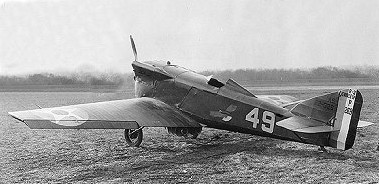
For 1924 Pulitzer, an R-3, won the race with a slow 346 km/h or 215 mph and was piloted by Lt. Harry H. Mills and after the race, those R-3 racers had been sent to McCook Field Museum.
3. Douglas A-20 Havoc - this has a company designation of DB-7 and it was a light bomber, intruder, an American attack, and night warrior aircraft of WWII. It served with some Allied air forces, mainly the USAAF or US Army Air Forces, the VVS or Soviet Air Forces, the AVMF or Soviet Naval Aviation and the RAF or Royal Air Force of the UK. It was used also by the air force France, the Netherlands, Australia, and South Africa during the war, then by Brazil afterwards.
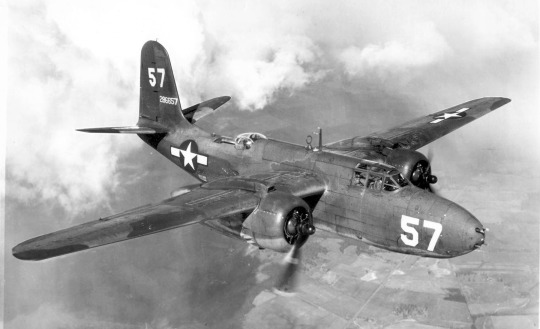
In the British Commonwealth air force, the attack/bomber variants of DB-7 were normally known by their service name “Boston”, whereas the intruder variants and the night fighter were normally known as the Havoc.
4. Huff-Daland LB-1 - this is a US biplane light bomber aircrafts operated in the 1920s.
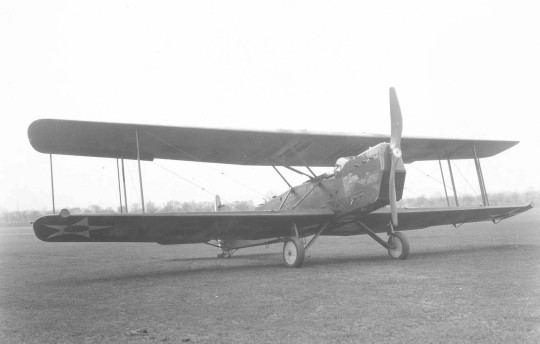
It is derived from an XLB-1 prototype taken in 1923 by the Army, the LB-1 advance aircraft was powered through the solo Packard 2A-2500 engines and carried the added crewman. It established underpowered in the service trials.
5. Martin B-10 - it was the first ever all-metal monoplane bombers to go in regular use and entered the service on 1934 of June. It was the first ever mass-produced bomber where performance base was the best to that of the Army's pursuits.
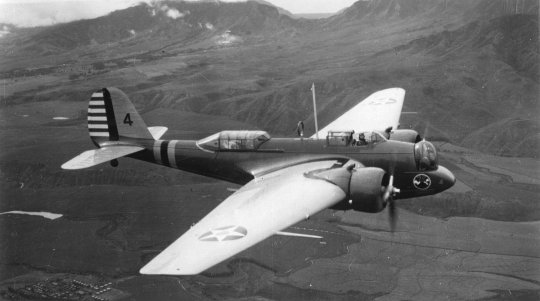
During its creation time, it became so advanced that it was described as an air power wonder. It was half as fast as with any biplane bomber, also faster than any other contemporary fighter. The only surviving full B-10 is now on display at US Air Force National Museum at Wright-Patterson AF Base near Dayton, OH. The AF Museum conducted a complete search for any existing B-10 remains that eventually heard of the aircraft. The aircraft was reinstated by the (Mobile) 96th Maintenance Squadron, AF Reserve, at the Kelly AF Base, Texas, in between 1973–1976, and then it was placed to show-off in 1976.
6. Douglas C-47 Skytrain - this C-47 was important to the victory of lots of Allied campaigns, precisely those at the jungles of Burma and New Guinea and at the Guadalcanal where this C-47 made it more likely for the Allied troops to oppose the mobility of a light-traveling Japan army.

C-47s were used for airlifting supplies to the embattled American forces through the Bastogne Battle and possibly its most significant role in the military aviation.
7. Waco CG-4 - this was the most extensive US cargo/troop military glider of WWII and CG-4As went into action in July 1943 through the Allied attack of Sicily. They partake in the US airborne landings on June 6, 1944 in Normandy, and in some other vital airborne operations in China Burma India stage and in Europe.
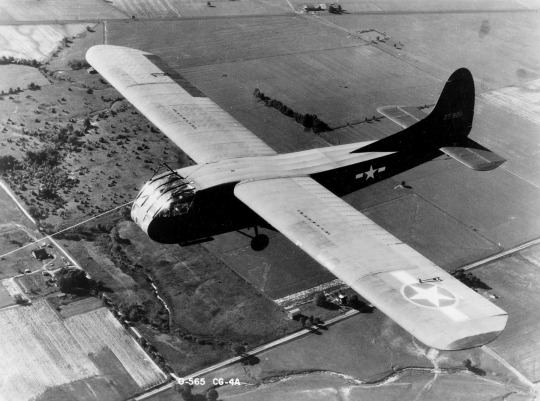
The CG-4A make favor where the small sizes were a benefit that it can land in tiny spaces. The CG-4A was used also to transmit supplies to the partisans in Yugoslavia. Right after WWII ended, most CG-4As remains were declared surplus or spare and almost everything was sold. The last ever known use of CG-4A was during the early 1950s through the USAF with the Arctic detachment aiding technical research.
8. Schweizer TG-3A - All in all, there were 114 TG-3As that has been built for the USAAF use. All of the remaining military TG-3As had been sold to individuals and gliding schools when the war ended.
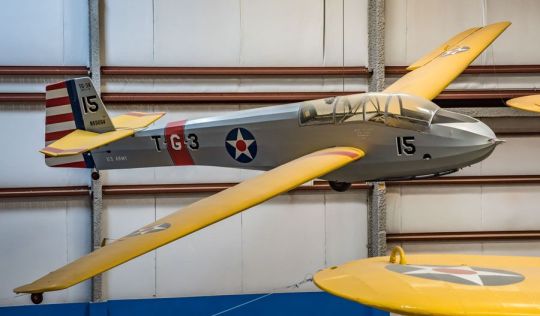
TG-3A was restored at the National Museum of US Air Force by Spartan Institute of Aeronautics in Oklahoma and was donated to a museum in 1980 of December. In March of 2011, there were about 29 from the TG-3As that has registered in the United States.
9. Boeing P-26 Peashooter - this has been the first ever American all-metal invention fighter aircraft and also the first chase monoplane used by US Army Air Corps. The prototype initially flew in 1932. This type was yet used with U.S. Army Air Corp in the Philippines in as late as the year 1941.

P-26As were flown also by the third PS of the fourth Composite Group, station in the Philippines. In between year 1937 and year 1941, 31 were traded to the hatchling Philippine Army Air Corp. By 1941 of December, the US fighter intensified in the Philippines incorporating 28 P-26s, and 12 of which had been operating with 6th Pursuit Squadrons of the Army Air Corps of the Philippines. Filipino-flown the P-26s claimed 1 G3M and 2-3 Mitsubishi A6M2 Zeros just before the final P-26s were burned on December 24, 1941.
10. Lockheed XH-51 - this was a 3-bladed, sole-engine experimented helicopter that was using a retractable slip landing gear and a rigid rotor.

Lockheed started developing the rigid rotor concept together with CL-475 helicopter styled in 1959. This rigid rotor choice was meant that a helicopter was livelier than it could have been with the flapping rotor. The routine of CL-475 encouraged the Lockheed to look for further development. However, in 1962 of February, Lockheed's Model 186, the latest design rigid rotor was chosen to be the winner of the joint Army-Navy plan to evaluate a rigid rotor for the high-speed flight abilities. On June 1964, the NASA ordered the 5-seat, 3-bladed variant as the helicopter test vehicle.
0 notes
Photo

$89.01 Only! ~ RAF Supermarine Spitfire mk1 British WW 2 Fighter Aircraft + delprado raf pilot, Military Aircraft Models, Aircraft Desk Models Check This Out!
0 notes
Text

Sentimental Journey! On her way back home!
#wingnutz360#warbirds#avgeek#aviation history#aircraft#aviation news and photos with david arkwright#aviation lovers#ww 2#military aviation#sentimental journey#b17
125 notes
·
View notes
Text
FLIGHTLINE: 202 - NORTHROP MX-324/334 AND XP-79
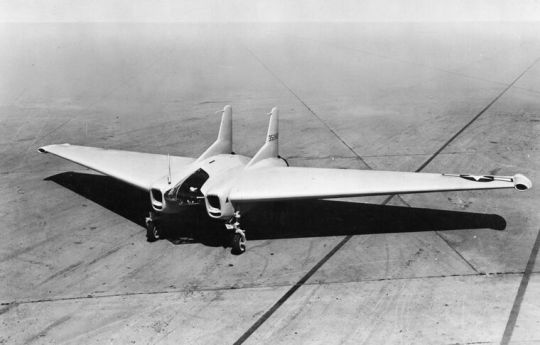
-Three-quarter view of XP-79B (s/n 43-52437) at Muroc AAF in 1945. | Photo: USAF
Early in WWII. the US was facing unknown, possibly overwhelming odds in the fight against the Axis Powers. As part of a push for innovative designs using as little strategically valuable materials (chiefly aluminum and steel) as was possible, Jack Northrop conceived of an interceptor constructed using magnesium, powered by a rocket engine, and with the pilot in a prone position to better withstand high g-forces. The US Army Air Forces was interested enough to award a contract to build three glider demonstrators, which Northrop designated the N-12 and which the USAAF called the MX-334.

-The Northrop N-12/MX-334 glider, used as proof-of-concept for the flying wing interceptor. | Illustration: Northrop Corp.
The first glider, a completely tailless design, was completed in Spring 1943 and was shipped to the NACA Langley center for testing in their wind tunnel. Testing indicated that the 334 was unstable at high speed, and so a wire-braced vertical fin was added to the second and third aircraft. Initial tow tests were carried out behind an unknown model of Cadillac, but the car lacked the needed power. Changes were made to the glider, and on 4 September 1943 it took off on its maiden flight behind an Army truck. More comprehensive testing began on 2 October, with the MX-334 being towed behind a P-38. Testing continued with both the #2 and #3 aircraft, although #3 was written off after test pilot Harry Crosby lost control of the glider after it entered the prop wash of the P-38.
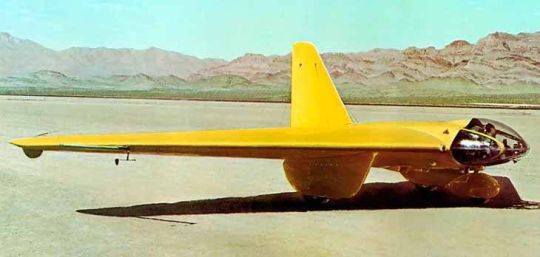
-One of the MX-334 gliders, with the additional tail fin in place. | Photo: Northrop Corporation
Early in 1944 the #2 aircraft was fitted with an Aerojet XCAl-200 rocket motor, which was rated at 2,000lbf thrust. This conversion changed the aircraft's designation to MX-324, which was the "secret" code number used for the rocket powered model. The maiden flight of the modified MX-324 was on 5 July, making the craft first American rocket-powered airplane to fly. The Aerojet engine, fueled by mono-ethylaniline fuel and red fuming nitric acid, proved to be unsuitable however, and testing was ended on 1 August, with the first and second aircraft being scrapped shortly thereafter. As a result of the test program and the subsequent failure of the XCAL-2000 engine, the design for the XP-79 was altered to replace the rockets with two Westinghouse 19B axial-flow turbojets of 1,150lbf thrust each.

-The MX-324 under rocket power during its first flight. | Photo: USAAF
The USAAF canceled the contract for the two rocket-powered XP-79, retroactively called the A model, and provided funds to convert the third prototype to jet power, with the aircraft now designated the XP-79B. Given the serial number 43-52437, the plane was fabricated from welded magnesium monocoque structure. The alloy, light but strong, had not been used in this quantity before, and Northrop faced challenges during the development of the XP-79 in learning to weld the metal. Jack Northrop, seeing reports of the damages inflicted on Allied fighters by Axis bombers, designed the aircraft to withstand a great deal of punishment, with skin thickness ranging from 0.75in on the leading edge to 0.125in on the tailing edge. This heavy duty construction has led to later accounts of the XP-79 being designed to ram enemy aircraft, but this is in error. Such a maneuver would be very difficult, and even with the exceptionally strong structure would likely result in the loss of both aircraft. Instead, production P-79Bs would be armed with a quartet of .50 Browning M2 machine guns.
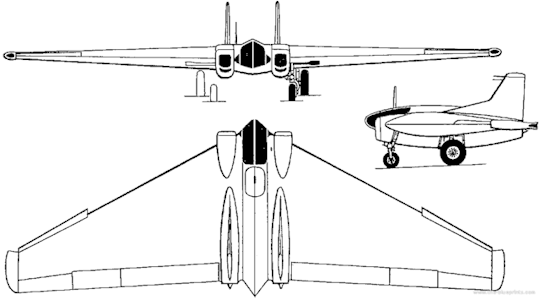
-Orthograph of the XP-79B. | Illustration: Northrop Aircraft
The P-79 was 14 feet long, with a wingspan of 38 feet and a height of just over 7.5 feet. The plane weighed 5,842lbs empty, and max weight was 8,669lbs. The twin 19B engines would propel the plane to an estimated cruise speed of 480mph and a max speed 547mph. The unique design of the aircraft resulted in the landing gear being made up of four legs instead of the usual tricycle arrangement, with the oleos retracting into the wings. The pilot lay prone between the two jet engines, with intakes fared into the wing leading edge, and twin rudders mounted above the exhausts. As a traditional control stick would not work with the pilot's prone position, a tiller bar and rudder pedals were provided. Adding to the unusual features of the P-79, the split ailerons had bellows-boosting, fed by intakes positioned just below the jet inlets. As was common with early jets, range was limited, with endurance limited to just 2.5 hours, and a range of about 1,000 miles. The thrust provided an exceptional climb rate of 4,000fpm however, and a max ceiling of 40,000 feet.

-The XP-79B on the dry lakebed at Muroc AAF. | Photo: USAAF

-Head-on picture of the XP-79, showing the very unusual pilot's position, landing gear arrangement and inlets. | Photo: USAAF
The XP-79B was rolled out early in 1945, after which it was transferred to the Army Air Force's Muroc testing site in June. High speed taxi tests resulted in a series of burst tires, delaying further testing while stronger tires were sourced. Finally on 12 September 1945 the XP-79B was readied for its maiden flight, with Harry Crosby at the controls. The test flight proceeded normally for the first 15 minutes, until during a slow roll Crosby lost control for reasons unknown. As the nose dropped the roll continued, with the plane entering a vertical spin. Crosby attempted to bail out, but he was hit by the plane's wing and knocked out, resulting in his death. The XP-79 struck the lakebed and burst into flames, completely destroying the aircraft.
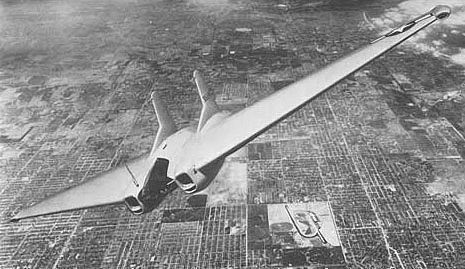
-The XP-79 on its sole flight. | Photo: USAAF
Although a second XP-79B (s/n 43-52438) was under construction, the USAAF saw no future in the design, and canceled further work. The incomplete aircraft was later scrapped, ending this chapter of Northrop's experimentation with flying wings
#Aviation#airplane#airplanes#aircraft#avgeek#wwII#wwii aircraft#ww2#ww2 aircraft#ww 2#ww 2 aircraft#Northrop#Northrop aircraft#flying wing#xp-79#northrop xp-79#prone position aircraft#weird wings
35 notes
·
View notes
Photo

'World War II woman aircraft worker, Vega Aircraft Corporation, Burbank, California, June 1942' by David Bransby (1942)
#david bransby#1942#world war II#world war 2#ww II#ww 2#vega aircraft corporation#aircraft#aircraft worker#woman worker#female worker#woman#female portrait#burbank#california#june 1942#june#photograph#photography#color photography#colour#color#film photographer#film photography#vintage photo#vintage photograph#vintage photography#World War Two#industry#aerospace
225 notes
·
View notes
Video
WWS-2 Żaba 'SP-167' by Alan Wilson
Via Flickr:
c/n unknown. On display suspended in the main display hangar at the Muzeum Lotnictwa Polskiego Krakow, Poland. 23-08-2013. The following info is taken from the museum website:- "This is a school glider of wooden construction with strutted high-wing configuration, designed by engineer Wacław Czerwinski. The prototype was built at the Military Gliding Workshops and was flown in 1937 at the Rakowice airfield in Krakow. Having good and safe-in flight construction - it entered into serial production at the WWS in Krakow, as the Żaba (frog). Experience gained during its service, led to the further development of the glider which became known as the Żaba-bis which was produced at the Aviation Workshops in Lvow. The Żabas were in service with all the gliding schools in Poland. Until the outbreak of the Second World War, 140 examples were built totally in Krakow and Lvow. Worth noticing is the introduction of ergonomic research, (done during the initial stage), which led to the designing of the specially shaped pilot's seat, which protected the pilot's backbone during "hard" landings. Also, introduced was the oil-pneumatic shock absorber placed between the landing skid and the trussed fuselage. One of the WWS Żaba-2, bearing the SP-1265 registration was hidden throughout the war in Krosno and after the war, it remained in service with the SP-167 registration since 1947 until 1950. It reached the museum's collection in 1964."
1 note
·
View note
Video
Die neue Art zu Reisen - II by Pascal Volk
#label#Etikett#Cargo aircraft only#Forbidden in passenger aircraft#Wide Angle#Weitwinkel#gran angular#ww#wa#Canon EOS 6D#Canon EF 35mm f/2 IS USM#35mm#35mmlens#SOOC
0 notes

